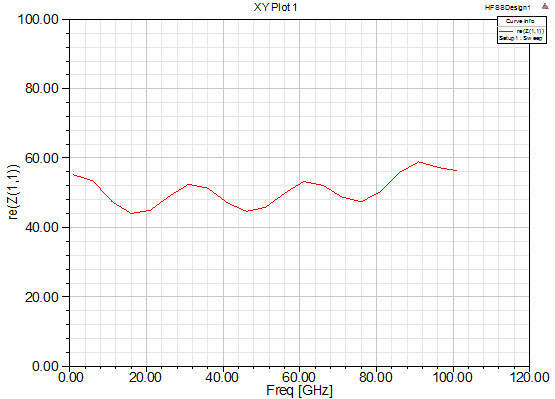HFSS Z11 analysis of CPW using waveports
I am a starter in HFSS simulation and I am tring to use HFSS to check my CPW design is 50ohm upto 50GHz.
I used waveport (the size follows the guideline in manual, and normalized to 50Ohm) at one side, and set the radiation boundary to all outer surfaces. The simulated Z11 is fairly close to 50ohm, which is reasonable to me.
Since I also want to know S11 and S12, I set another waveport2 (normalized to 50ohm) at the other side of CPW. However, the result becomes more standing-wave like (peaks at certain frequencies)
So does it mean if I want to know the impedance of my structure, I should only use 1 ports?
Thank you!
Welcome ycwu,
If the input impedance varies as a function of frequency, it means that your line is not matched.
What is the line terminated in in the first case? An open circuit?
Thank you!
The pictures of the first scheme is uploaded for clarity. I suppose the radiation boundary make small amount of reflection at boundary so it should be neither open and close end. Or the setup is not right?


Yes, so if the far waveport is not there, you basically have just a TL against the radiation boundary, which will cause any kind of reflections. Terminating the line in a waveport or matched load are the only way to ensure proper matching.
Hi,
So the images above are the result with one waveport + radiation boundary (the sheet at the far side is a non-model object)
And then I used two waveports scheme by assigning the sheet as waveport2 and also set all other surface as radiation boundary. The result I got is shown below, it seems like it doesn't has better match than scheme 1 (only one waveport)
,which I don't know why.
Thank you

The wave-port will always match itslef to the TL. Check to see what the port Zo is (for both ports) -- is it what you expect?
You do a serious mistake by observing Z11.
Z11 is NOT the Input Impedance while the other port(s) is(are) terminated.Z11 looks good because your Transmission Line behaves almost as open circuit ( or it has high Characteristic Impedance and it varies by the frequency) so Z11 becomes closer to 50 Ohm which is Port Impedance at the same time.It's a big mistake..
For a reasonable result, ALL ports must be terminated then EM simulation should be done.Then check your S11 and calculate ( look at directly on the Smith Chart ) your Input Impedance..
Thank you BigBoss.
I don't know if I got it right. So you are saying if I want to know the transmission-line input resistance. I should used two ports at two ends. And only use Smith Chart to calculate input impedance?
And: one port + radiation boundary is wrong?
and there is no direct way to ask HFSS to generate a plot like input impedance vs frequency?
Thank you!
Yes, it is wrong. The incident wave will be entirely absorbed if the line is matched by a port or load; a radiation boundary is NOT matched to your transmission line.
As stated above, it's best to start with S11 and derive additional parameters from there.
